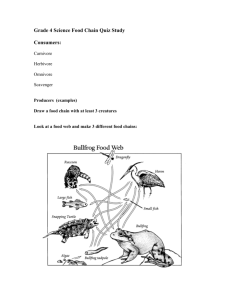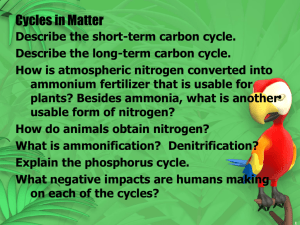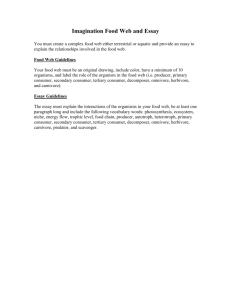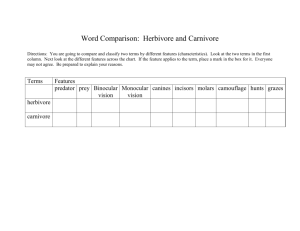Ecological Relationships
advertisement
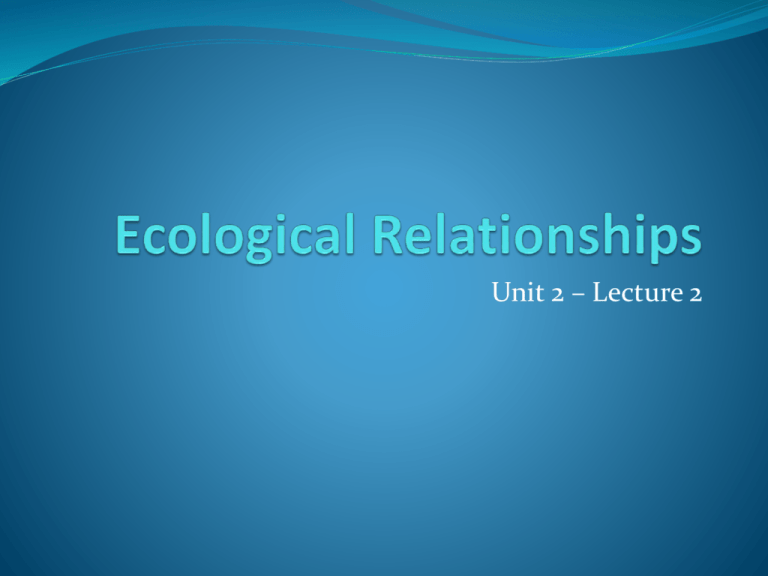
Unit 2 – Lecture 2 Ecology Ecology the relationship between an org and its environment Includes relationships between biotic and other biotic factors biotic and abiotic factors Important Concepts Habitat – where an org lives [tree, lake, burrow…etc] Niche – what an org does making dams, eating certain orgs, etc. EVERYTHING it does, basically. Biotic Biotic Relationships Symbiosis – a relationship between 2 orgs three types that we will cover: mutualism – benefit-benefit often referred to as simply symbiosis, but you must use the more specific term commensalism – benefit-unaffected parasitism – benefit-harm Discuss Come up with 2 examples of each of the symbiotic relationships: mutualism [benefit-benefit] commensalism [unaffected-benefit] parasitism [harmed-benefit] BioticBiotic cont’d Other – Non Symbiotic – Relationships Predator-Prey – one org feeds off of the other Competition – organisms compete for the same resources Food Chains & Food Webs Do Not list humans, decomposers, or scavengers. detritovore – feeds off of detritus [dead or decaying organic matter] – decomposers/scavengers Food Chain – a linear representation of feeding chains are linear – a single line ex: Food Chains & Webs – cont’d Food Web – a branched & often interconnected representation of feeding webs have many branches and interconnections ex: Descriptive Org Terms Autotroph – an organism which makes its own food “auto-” – self “troph” – nutrients / food / feeder aka producer examples? Descriptive Org Terms – cont’d Heterotroph – cannot make its own food, feeds off of other organisms “hetero” – different aka consumer “vore” terms – carnivore, omnivore, herbivore, detritovore/decomposer Discuss What do each of these “vore” terms mean? carnivore omnivore herbivore detritovore Descriptive Org Terms – cont’d decomposer – obtains nutrients by breaking down decaying organic matter organic – any substance containing the element Carbon Sequence Terms for Consumers Used in food chains or food pyramids for CONSUMERS, NOT in food webs. You may use either of the given terms. Primary aka First Order consumers eats the producer herbivore or omnivore Secondary aka Second Order consumers eats the primary/1st order consumer omnivore or carnivore Sequence Terms – cont’d Tertiary aka Third Order consumer eats secondary / 2nd order consumer carnivore or omnivore Quaternary aka Fourth Order consumer eats tertiary / 3rd order consumer carnivore or omnivore etc… Terms in Chains & Pyramids Top Predator – an animal with has no natural enemies will always be final step in food chain / pyramid NOT all pyramids & chains have a top predator HUMANS ARE NOT TOP PREDATORS… Discuss / Complete Fill in #4 on your sheet using the terms you just learned in #s 1-3. [sequence terms, vore terms, and the rest] Check Your Work! Producer Heterotroph Heterotroph Heterotroph Autotroph 1st Order Consumer 2nd Order Consumer 3rd Order Consumer Primary Consumer Secondary Consumer Tertiary Consumer Omnivore Carnivore Carnivore Top Predator Energy/Food Pyramids Energy Pyramid – a pyramid-shaped representation of a food chain shows the transfer of energy btw organisms only 10% of the energy taken in is passed on to the next trophic level 90% of energy taken in is lost [used for fuel for the body’s actions and for body’s reactions] Energy/Food Pyramids Energy Pyramid – a pyramid-shaped representation of a food chain trophic level – a nutrient/food level [“troph…” each step in a food chain, web, or energy pyramid is a new trophic level a pyramid will have as many levels as the food chain it represents Energy/Food Pyramids the terms used to describe orgs on the food chain are also used for each trophic level here. as available energy decreases, the number of organisms [circle one: also decreases / increases]. Homework Complete the Food Chains, Food Webs & Food Pyramids worksheet found on pages 6-7 in your packet.

